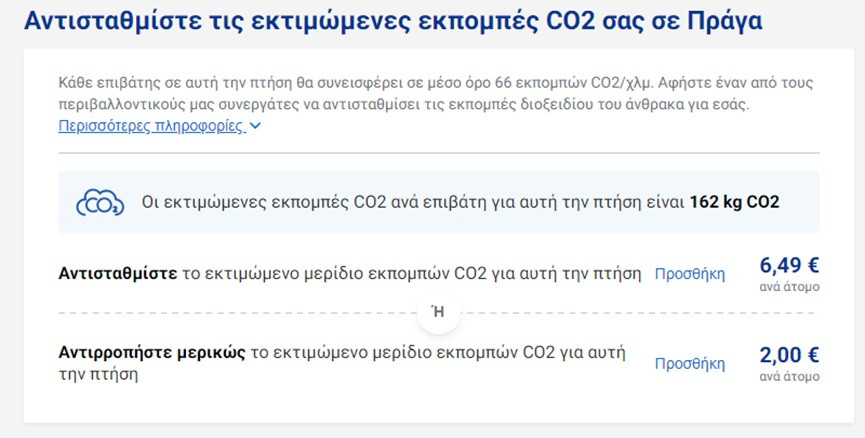How ΄green΄ is my flight?

"Don΄t click ΄OK΄ when your airline asks to ΄reduce΄ the environmental footprint of your flight."
(Spyros Skiadopoulos) Travel has now become one of our 'hobbies.' You see it in bios, you see it in Instagram stories. So, I too was getting ready to book a flight to Prague. I was excited, already imagining the Charles Bridge, the narrow alleys and the medieval castles. When I reached the payment page, I noticed an option that particularly caught my attention.

My flight would emit 162 kg of carbon dioxide (CO2). However, with just €6.49, I could "offset" the carbon emissions of my flight. And, if I were feeling stingy, I could partially offset the emissions for only €2.
Perfect! I thought, why not? It’s just a few euros to make 162 kg of CO2 disappear. As if I hadn’t flown at all.
But something didn’t sit right with me. If €6.49 could so easily erase 162 kg of CO2, why didn’t I do it every day? How could a flight burning tons of fuel "vanish" from the environmental balance sheet so cheaply? I started digging deeper to understand how "carbon offsetting" works. The more I researched, the more I realised the picture was much more complex… and rather disappointing.
Carbon Offsetting and Greenwashing
The basic idea of carbon offsetting seems good: CO₂ emissions generated by an activity are balanced by supporting projects and activities that reduce or capture emissions, such as tree planting, funding renewable energy, or protecting forests. In practice, however, many projects promoted by companies turn out to be ineffective or of dubious value.
This is where "greenwashing" comes in—deceptive practices that make companies appear more environmentally friendly than they really are. Trees planted may not survive long enough to capture the promised CO₂. Other projects, like forest conservation, merely preserve existing natural resources without adding anything substantial to the fight against the climate crisis. Through carbon offsetting, many airlines give the impression of offering a "green" option to travellers while essentially continuing to operate as before, relying entirely on polluting fuels.
Instead of solving the problem of emissions, carbon offsetting often conceals it. It creates the illusion that we can continue travelling and consuming endlessly without real consequences for the environment.
It fosters the notion of a "cheap solution." Think about it. How is it possible to offset such emissions so easily with such a small amount of money? The climate crisis cannot be solved with temporary fixes or cheap excuses.
Our Planet Needs Actions, Not Illusions
The real solution isn’t paying for a "clean conscience" but changing how we travel and live. This means, first and foremost, flying less and avoiding long distances. When possible, we can choose trains (for distances of 200–1,000 km) and buses (for distances of 100–500 km), which have a much smaller footprint.
At the same time, we can support reliable organisations working to protect the environment (like Greenpeace, ARCHELON, WWF Greece, etc.) and pressure companies and governments to invest in sustainable infrastructure and clean technologies. As consumers (and let’s face it, we all are), we can use our spending choices and our voices to demand that major companies adopt more environmentally friendly practices. Our behaviour has power, but change won’t come through easy solutions. I’ll save more practical suggestions for the future!
As consumers, travellers, and citizens, we can make a difference—not by buying carbon offsets that ultimately don’t work, but by making slightly harder but more responsible choices and actions.
SPYROS SKIADOPOULOS










